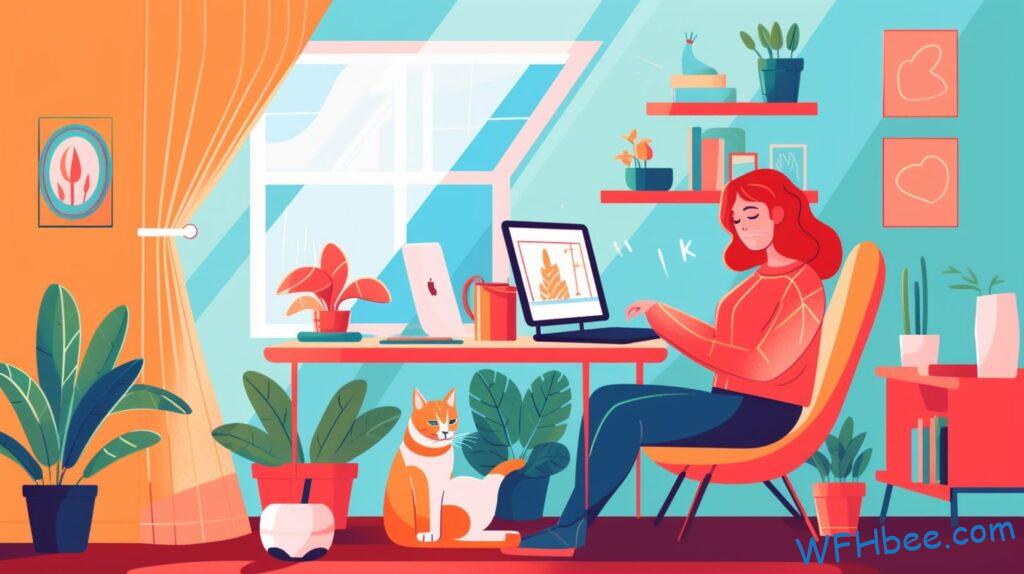Working from home is like steering a boat through choppy waters. It can be difficult to navigate, and there are plenty of distractions that keep you off course. But with the right equipment and proper guidance, it’s possible to stay on track – even when working long hours at home. Whether you’re new to remote work or an experienced veteran, this article will provide helpful tips for managing your workload while maintaining a healthy balance between life and work.
The idea of working remotely has become increasingly popular in recent years as technology continues to make it easier than ever before. As more companies adopt flexible policies, employees have been given greater freedom and control over their own schedules. While these benefits are plentiful, they come along with some challenges – especially if you’re expected to put in extra hours during any given week. Working from home requires discipline and dedication; here are some tips for making sure your productivity remains high throughout the day regardless of how long you’ve been sitting in front of your computer screen!
From setting up boundaries around office space to taking regular breaks away from the desk, there are several strategies that can help boost focus and motivation when tackling longer-than-usual days at home. In this article we’ll explore ways to increase efficiency without sacrificing self-care habits or mental wellbeing. Keep reading for essential advice on staying productive (and sane) while getting through those marathon workdays with ease!

Table of Contents

Definition Of Working From Home
Working from home has become more popular in recent years, and it offers various advantages over traditional employment. Working from home is often referred to as telecommuting or remote employment, and it involves carrying out duties away from the office environment. Home-based work isn’t limited to one sector – it can include a range of job types such as freelance writing, software development and customer service.
Before jumping into the benefits of working from home, let’s take a look at how this type of job fits into our lives. With the advancement of technology, we are now able to access all sorts of information online which makes working remotely much easier than ever before. Additionally, this way of life allows us to manage our own time better; for example, we can choose when to take breaks without having someone constantly monitoring us. This freedom provides an added incentive that motivates many people towards pursuing a flexible lifestyle by opting for remote work opportunities.
The key here is balance: making sure you still have time for yourself outside of your career ambitions. Having said that, the flexibility afforded by working from home gives us plenty room to create that balance between personal and professional life – something equally important in both aspects! And with that thought in mind, let’s turn our attention to some of the benefits associated with telecommuting…

Benefits Of Working From Home
With the rise of technology and remote work opportunities, working from home is becoming increasingly popular. There are many benefits to this type of arrangement: flexible hours, improved productivity, better work-life balance – just to name a few.
First, working from home allows for more flexibility when it comes to scheduling. Employees can choose their own hours that best fit both their personal and professional needs without having to worry about being at the office during certain times. This provides them with an opportunity to manage their time more effectively so they can get the most out of each day.
Second, employees who have the option to work remotely tend to be more productive than those in traditional settings due to increased focus and fewer distractions. Working from home also eliminates commute time which gives employees extra free time that can be used towards other activities such as exercise or leisurely pursuits like reading or playing video games. The lack of commuting stress also helps improve employee morale by allowing them to avoid traffic jams, loud noises, and long lines.
Lastly, one major benefit of working from home is the improved work-life balance it offers. Because there’s no need for a physical presence at the workplace every day, employees have more control over how much they want to and should devote themselves into their job while still leaving enough energy for family and friends outside of work. With this kind of freedom comes a sense of liberation and satisfaction knowing you don’t always have to be confined within four walls all day long but instead have the power to make your own choices when it comes to managing your life commitments.
Working from home certainly has its advantages; however, these come with some challenges too which will be discussed in the subsequent section…
Challenges Of Working From Home
As the saying goes, “Nothing worth having comes easy”. Working from home is no exception; it presents its own unique challenges that must be addressed in order to succeed. One of the biggest obstacles for those working remotely is finding compatible work/life balance. When your office and living space are one and the same, setting boundaries becomes even more important than ever before. Additionally, remote workers also face difficulty staying focused due to a lack of structure or colleagues nearby to spur motivation when needed.
The need for social interaction can also become an issue since most people don’t have coworkers around during their day-to-day tasks at home. This could lead to feelings of loneliness and isolation which can significantly hamper productivity over time. Furthermore, working remotely often requires additional self-discipline with regard to taking breaks throughout the day – something that’s much easier said than done!
It’s clear that there are definitely some hurdles associated with working from home, but thankfully there are ways to mitigate them. By making sure you have a designated workspace and creating a schedule that allows for restorative downtime every once in awhile, you’ll be well on your way toward success as a remote worker. With these strategies implemented into your daily routine, you’ll be ready to tackle the next step: setting up an ideal home office environment!

Setting Up An Ideal Home Office
When working from home, one of the most important steps is setting up an ideal workspace. It’s essential to create a comfortable and organized area that allows for maximum productivity. Here are three tips for creating your perfect home office setup:
- Invest in quality furniture and equipment: A good chair and desk will make all the difference when it comes to comfort and efficiency while you work. Make sure they are ergonomically designed to reduce fatigue, promote better posture and encourage concentration. Additionally, make sure you have the right tools for the job such as a laptop or desktop computer with adequate RAM to support your work needs, plus any other peripherals like printers or scanners that may be required.
- Establish organizational systems: Staying organized can help minimize distractions so you can focus on completing tasks efficiently. Take time to set up filing systems — physical or digital — which will help keep documents in order throughout the day. Consider investing in storage solutions such as shelves, cubbies and drawers to store everything neatly away when not in use.
- Add personal touches: Working from home doesn’t need to feel sterile or uninviting – add some personality by adding plants or artwork! Personalizing your space with items that inspire motivation and creativity can help boost morale during long hours at the desk. Plus, having reminders around you of what makes you happy can also reduce stress levels associated with extended periods of sitting down too much!
By following these simple steps, anyone can easily create their own ideal workspace environment at home – free from distraction but full of inspiration! Now that you have created a conducive workplace atmosphere, it’s time to establish a routine that works best for you; this way success is guaranteed no matter where you choose to work from!

Establishing A Routine
Creating a routine is essential when working from home. This also includes organizing your lunch breaks. It can help you stay focused, motivated and on track for completing your tasks. Establishing a daily work-from-home routine will help make sure that you’re getting the most out of your day.
First, start by creating a schedule that works around your lifestyle and commitments outside of work. This could include scheduling time to finish specific tasks or blocking off chunks of time dedicated solely to work. Make sure you are also taking regular breaks throughout the day as this will keep you refreshed and productive in the long run.
Next, set goals for each day that are realistic yet challenging so that you feel accomplished at the end of the day. Prioritize these tasks according to their importance and complexity – it’s best to get through higher priority items first before tackling less important ones later on in the week if need be.
Finally, don’t forget to reward yourself once all those goals have been achieved! Whether it’s taking some extra time off or treating yourself with something special – celebrating small successes makes those big accomplishments even sweeter! Transitioning into an effective work-from-home routine takes some practice but once established, it will become second nature over time.

Prioritizing Tasks
The key to successful working from home is staying organized. To stay productive and get the most out of each day, it’s important to prioritize tasks in order of importance. Here are three tips for task organization:
- Task Planning – When beginning a new project or tackling an existing one, make sure you have a plan of action. Clear goals will help keep your work on track and ensure that nothing gets overlooked or lost in the shuffle.
- Task Delegation – If possible, delegate some of your tasks to others who can complete them faster or more efficiently than you can. Utilizing the power of collaboration allows everyone involved to benefit by saving time and energy while producing better results.
- Be Flexible – Even with proper planning and delegation, there may be times when unexpected issues arise that need attention right away. Being flexible enough to adjust as needed is essential so that no deadlines are missed or projects abandoned mid-way through completion.
By utilizing these strategies, you’ll be able to create an effective workflow and maximize productivity throughout the day—all without sacrificing the freedom of working from home! But remember; don’t forget to schedule regular breaks too!

Scheduling Breaks
The key to productivity while working from home is in learning how to effectively schedule breaks. Like a river that carves its way through the land, one must take moments of respite in order to make progress over time. Taking regular breaks throughout the workday can help refresh your mind and recharge your creativity. Break scheduling should become an important part of organizing your day-to-day tasks when you are working remotely for extended hours.
One approach is to plan short intervals between each task or activity where you step away from the computer screen and do something else unrelated to work. This could include activities like stretching, having a snack, listening to music, taking a walk around the block, calling a friend, reading a chapter of a book, etc. These brief pauses will allow you to gain clarity on whatever project or task you’re focusing on and come back feeling refreshed and ready to tackle it with renewed vigor.
By appropriately planning out break scheduling into your daily routine, not only can it improve concentration levels but also prevent burnout by providing ‘breathing room’ within long periods of intense focus. With this freedom comes ownership and responsibility as well; instead of relying solely on external factors for motivation, recognizing our own need for breaks allows us to reclaim control over our personal workflow. As you transition into the next section about keeping interruptions at bay, remember that balance is essential – both in terms of productive effort and relaxation!

Keeping Interruptions To A Minimum
Working from home can be a liberating experience, but it also has its own unique set of challenges. One of the most prominent issues is dealing with interruptions and distractions that come without having an office environment. Here are five tips for minimizing interruptions while working from home:
- Establish clear boundaries with family members or roommates in regards to when you’re available or not. Let them know your work hours and what constitutes as acceptable interruption during those times.
- Find a quiet space where you can focus on your tasks undisturbed by noise, such as video games, TVs, music etc., even if this means temporarily relocating to another room or outside area in good weather conditions.
- Utilize technology to stay focused – use apps like StayFocused which limit time spent on distracting websites; make sure that notifications aren’t enabled on devices; mute group chats when they become too much of a distraction.
- Make sure to take breaks throughout the day so that distractions don’t pile up – get some fresh air, do something active, talk to someone who isn’t related to work, listen to calming background noise such as nature sounds or classical music etc..
- Have contingency plans ready should anything disrupt your workflow – have alternative projects prepared for days when concentration is hard or establish specific techniques used for alleviating stress caused by any type of unwanted intrusion into your workspace.
By following these steps, one can create an optimal environment for productivity and success within their job responsibilities without feeling overwhelmed by obstacles created by circumstances out of one’s control. To further enhance effectiveness while working from home, utilizing technology is key…

Utilizing Technology
When it comes to working from home, technology is a must. Telecommuting allows us to access our work anywhere with an internet connection. Virtual meetings and remote collaborations are great ways to stay connected with colleagues while still being productive in the comfort of your own home. By utilizing technology, we can take advantage of globalization by connecting with people around the world for business purposes or socializing with friends and family when there’s time for a break. Technology also helps us keep track of tasks and objectives throughout the day so that nothing slips through the cracks. All these tools help increase productivity and make sure projects remain on schedule despite working away from the office environment.
By now, you’ve already become familiar with how telecommuting works; however, one thing many forget about is staying motivated and focused during long hours at home. It’s easy to get sidetracked by household chores or other daily activities when you don’t have someone looking over your shoulder like in a traditional workplace setting. To avoid this, it is important to set boundaries between personal life and professional commitments even though they may be intertwined more often than not when working remotely. Focusing on goals without getting distracted will ensure that all tasks are completed efficiently no matter where you might be located.
Therefore, understanding how technology can improve our workflow as well as finding ways to stay focused are essential components of successful remote working arrangements. With just a few adjustments here and there, anyone can turn their house into an efficient workspace!

Staying Motivated And Focused
Now that you have the proper technology set up to begin working from home, it is important to stay motivated and focused. It can be difficult when there are no colleagues around for support. Here are some tips for staying on task:
Set a schedule – Having a daily routine will help keep your focus so that you don’t get easily distracted. Setting goals both short-term and long-term will also help motivate you because you will have something tangible to work towards.
Take breaks – Taking mini-breaks throughout the day helps refresh your brain so that you don’t become mentally exhausted. Go outside or take a walk if possible; this will give you time away from your computer screen as well as allow yourself to reset in order to stay productive later on.
Stay organized – To avoid becoming overwhelmed by all of your tasks, create lists or use an organizer app with reminders so that nothing gets overlooked during the day. This way, when it is time for bed, tasks won’t be lingering over your head causing unnecessary stress and worry at night.
Staying professional, motivated and focused while working from home isn’t always easy but it’s doable with the right mindset and techniques. Now let’s discuss how managing stress levels can ultimately lead to increased productivity…

Managing Stress Levels
Maintaining a healthy work-life balance when working from home can be difficult, especially if you’re working long hours. This is why it’s important to take the time to manage your stress levels and practice effective stress relief techniques.
Here are some tips for managing stress while working from home:
- Break up tasks into smaller chunks and build in breaks throughout the day: Breaking up large projects or tasks into smaller ones helps make them more manageable. It also allows for built-in mini-breaks throughout the day that help keep you energized and focused on what needs to get done.
- Take regular exercise breaks: Exercise has been proven to reduce stress hormones such as cortisol in the body. Taking regular exercise breaks during the day can help relieve tension and clear your mind so you can focus better on your work.
- Practice mindfulness activities: Mindfulness activities like yoga, meditation, deep breathing exercises, or journaling can all help lower stress levels and give you clarity of thought during times of high pressure or anxiety.
These strategies will not only help with maintaining mental health but they’ll also improve productivity too! If you incorporate these simple steps into your daily routine, you’ll find yourself feeling less stressed out in no time at all. With this newfound sense of calmness, transitioning into dealing with loneliness may become much easier.

Dealing With Loneliness
Working from home can be incredibly isolating. It’s easy to feel lonely when you don’t have a colleague or team around for support and companionship. The lack of social interaction in the office environment can lead to feelings of loneliness while working from home, which many people find difficult to cope with.
A great way to combat this is to make sure you take regular breaks throughout your workday – even if you are at home by yourself. Take advantage of any outdoor space available near where you live and go out for walks during lunchtime or between tasks. This will help bring some fresh air into your day and provide an opportunity for a much-needed change of scenery. Additionally, try scheduling virtual coffee catch ups with colleagues every now and then so that you can keep up those important connections while staying socially distant.
If it’s within your budget, consider investing in online classes or activities related to something new that sparks your interest such as yoga, art, or cooking! Anything that encourages creativity and improves wellbeing should make a difference when dealing with loneliness while working from home. Furthermore, joining online communities based on shared interests can also help create meaningful relationships outside of the workplace setting.
These strategies may help to reduce feelings of isolation associated with long periods spent working remotely; however, there’s no one size fits all solution for everyone. Keep experimenting until you discover what works best for your personal situation and remember: being honest about how you’re feeling goes a long way towards taking care of yourself mentally and emotionally through these uncertain times. As we move onto maintaining professionalism…

Maintaining Professionalism
Now that you have dealt with the loneliness of working from home, it is important to maintain professionalism. This includes professional communication, attire and behavior. Through video conferencing tools like Zoom or Skype, make sure to dress professionally as if attending a meeting in-person. Being dressed appropriately helps create an atmosphere of respect and boosts confidence – both are essential for successful meetings and interaction. Professionalism also means keeping your workspace neat and organized. Clutter can be overwhelming, distracting and cause stress when trying to focus on tasks at hand.
Additionally, use appropriate language while communicating over email or phone calls. It’s easy to let our guard down when talking amongst ourselves but avoid using slang terms or taking shortcuts in writing emails as this can give off a negative impression about one’s work ethic. The same goes for text messages; try not to get too casual with colleagues even outside of work hours.
It is also important to set boundaries between personal and professional life by creating a flexible schedule that works best for everyone involved. Set realistic goals each day based on what needs to be accomplished without sacrificing time for rest and relaxation activities such as exercise, reading or hobbies which help balance out the workload so that productivity does not suffer due to burnout. With these tips in mind, effective time management strategies will ensure success in achieving desired results while working from home!

Effective Time Management Strategies
Interestingly, over 50 million Americans are now working from home due to the pandemic. With this comes a greater need for effective time management strategies so that we can make the most of our days and keep ourselves productive while doing so.
One key strategy is setting daily goals and breaking them down into smaller tasks. This helps you manage your time better as it gives you something more achievable to work on every day rather than having one huge goal looming over you. Additionally, being mindful about how much time each task takes will help you plan out your day better and become more efficient with your workflow.
Another important tactic when it comes to managing your time effectively is self-discipline. Establishing boundaries between work and leisure activities allows us to stay focused during work hours whilst also giving us an opportunity to relax at the end of the day which can be difficult when working from home. Try creating a schedule that works best for you and stick to it!
These simple yet effective tips can make all the difference in achieving long-term success while keeping up with healthy habits. Now let’s look at some tips specifically designed for those of us who might be spending too many hours behind our desks…

Tips For Working Long Hours
It’s no secret that working from home can be a challenge. Working long hours can take its toll on your mental and physical health, leading to fatigue, burnout, and even depression if left unchecked. Fortunately, there are ways to make the most of working long hours while still preserving your well-being. Here are some tips for working long hours:
Set Boundaries: One key to successful work-from-home is setting boundaries between work life and personal life. This means taking regular breaks throughout the day to step away from your desk or laptop and do something else – whether it’s going for a walk or just doing some light stretching exercises. It also means creating designated times when you will not respond to emails so that you can focus on other things like family time or self-care activities without feeling pulled in multiple directions at once.
Create Structure: Having structure in place during extended periods of working helps us stay focused and productive. Create a schedule for yourself with clear start and end times each day as this will help keep distractions at bay by giving you specific tasks to complete within certain amounts of time. Additionally, break down your workload into manageable chunks rather than trying to tackle it all at once; this will prevent you from becoming overwhelmed or discouraged by how much remains undone at any given moment.
Prioritize Rest & Recharge: Working long hours requires energy reserves which need replenishing often through adequate rest and relaxation. Make sure that every night before bed you give yourself enough time to wind down and get ready for sleep so that you aren’t starting off the next morning exhausted already. Regularly taking days off where possible is important too — use them as an opportunity to hit reset mentally and physically so that when it comes time to check back in with work again, you’re refreshed and recharged!

In Summary
Working from home can be an amazing experience if done correctly. It’s often seen as a less stressful, more productive environment than that of the office. However, it comes with its own unique set of challenges such as dealing with loneliness and finding ways to stay motivated for long hours. By following the tips outlined in this article, you’ll find yourself working smarter, not harder!
You’ll be able to establish a routine that works best for you and maximize your productivity while still taking care of yourself mentally and physically. I am convinced that by putting these strategies into practice you will become an absolute powerhouse when it comes to working from home!
There’s no limit on how much success you can have – just make sure to create boundaries so that work doesn’t take over your entire life. With the right attitude and mindset, working from home can be one of the most rewarding experiences anyone could ask for!
Author: Robin Borg
Hi, I’m Robin. I have been working from home at least one day a week during all of my adult life. I have a background in research and data science. Get to know me better in the About page.







